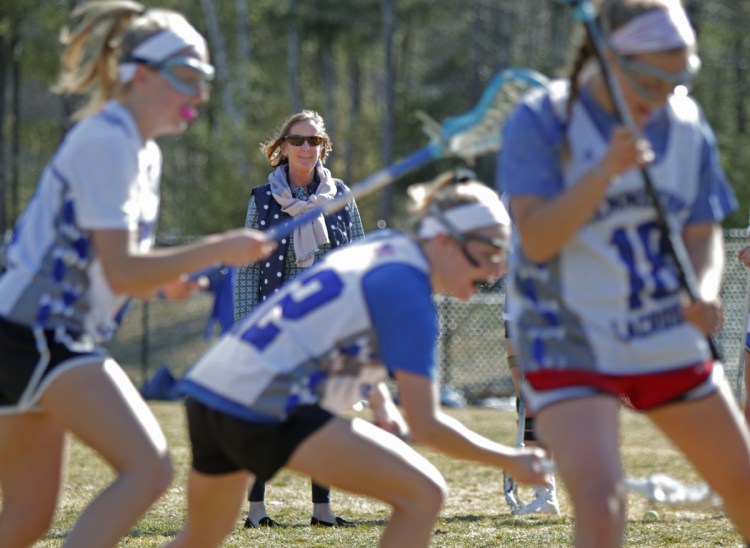For girls’ lacrosse, the addition of a third enrollment class this year brings some uncomfortable – albeit temporary – changes.
Some long-existing rivalries have been broken up. Classes B and C don’t have enough schools to split into two regions, meaning they won’t have traditional North vs. South state championships.
“I like having the regional champs play each other in the state final. It’s kind of classic,” said Freeport Coach Marcia Wood, whose team was reclassified from Class B to C. “More schools are joining so at some point it was going to happen. I just didn’t know if it really needed to happen quite yet.”
The Maine Principals’ Association added Class C this season to give new and smaller programs a place to grow while offering struggling programs – regardless of enrollment – an opportunity to rebuild with the caveat that those schools wouldn’t be allowed to compete in the postseason.
Though some coaches think the move was premature, it reflects a positive trend for lacrosse: The sport is growing across the state.
“Part of the conversation was: ‘Why this year?’ ” said Morse Coach Linda Levesque, who has been a liaison on the MPA lacrosse committee for almost two decades. “One of the huge reasons was the competitive balance for the newer and smaller schools and also for the bigger schools that have been struggling.
“It’s sort of like growing pains.”
The decision was made with the anticipation of more growth to come. With 46 girls’ teams competing this season, Levesque said schools such as Gray-New Gloucester, Maranacook-Winthrop, Maine Central Institute, Houlton and John Bapst have expressed an interest in potentially adding girls’ lacrosse.
“Obviously we were thinking ahead,” Levesque said. “We’re adding teams almost every year.”
As more schools join, the single-region classes will split into North and South. Levesque said the MPA typically divides classes into two regions of eight teams once they total 16. Class A (enrollment 800+) had enough this season with 19 teams, including Bangor’s new program, while Class B (enrollment 600-799) fell just shy with 15. Class C (enrollment 0-599) has 12 teams.
While no Class A or B-sized school opted to move down to Class C this season, some well-established programs petitioned to play up a class, which the MPA allowed.
Marshwood (781), Falmouth (696), Kennebunk (678) and Cheverus (467) petitioned to move up to Class A. Cape Elizabeth (537), Yarmouth (525) and Waynflete (262) will play in Class B by choice.
“You see some classic, traditional rivalries that are going to shift or go away,” said Falmouth Coach Ashley Pullen. “Maybe we’ll see some new rivalries come out of this, which is always exciting. It’s a balancing act of trying to continue to find crossovers to honor those previous rivalries and also kindle some new ones.”
Falmouth has lost to Kennebunk the two-time defending state champion, in the Class B South final for the past three years. But with Falmouth now in Class A North and Kennebunk in Class A South, they only can face each other for the state title. Meanwhile, Kennebunk’s road back to the state final will be tough this season now that it shares a region with Massabesic, the Class A champion.
“Massabesic has been a crossover for us and it’s always a tough game,” Kennebunk Coach Annie Barker said. “Now we’ve got to get through Massabesic to get to Falmouth (if Falmouth wins the North).”
The dynamics of competition also have changed for Class B teams such as Yarmouth, which fell to Kennebunk 5-4 in last season’s state final.
The Clippers retain tough regional competition in longtime Class B rivals such as Cape Elizabeth, Waynflete and Greely. They’ll also face five former Class A schools that have been reclassified: Biddeford, Messalonskee, Brunswick, Westbrook and Mt. Ararat.
“We’re all going to miss each other,” Yarmouth Coach Dorothy Holt said of Kennebunk and Falmouth. “We can still have the rivalry. It’s just different because we’ll never meet in the state game.”
The change mostly will be felt in the playoffs. As has been the case in previous years, the teams’ regular-season games will remain mostly against conference opponents with the option of up to four crossover games.
But with the way programs have shifted, teams in the same conference are much less likely to share the same class or region, limiting their exposure to teams they might face in the regional playoffs.
Falmouth, for example, only faces three Class A North opponents on its 12-game schedule. Freeport will face six Class C teams.
“Numbers-wise, (Class C) is a good fit for Freeport … Our schedule has changed a little bit but not too, too much,” Wood said. “But if we can’t compete against the B teams, we won’t get those Heal points. Right now it’s just about getting the Heal points to get into the tournament.”
Taylor Vortherms can be contacted at 791-6417 or:
tvortherms@pressherald.com
Twitter: TaylorVortherms
Send questions/comments to the editors.


